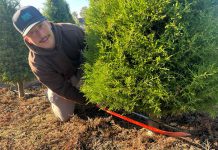
Some San Benito ranchers angered by Pinnacles plea to use
non-lead ammo in condor country
A series of community meetings hosted by Pinnacles park staff to
educate the public about San Benito’s condor flock resulted in some
surprising reactions from local ranchers, who question the
viability of the recovery effort.
Some San Benito ranchers angered by Pinnacles plea to use non-lead ammo in condor country
A series of community meetings hosted by Pinnacles park staff to educate the public about San Benito’s condor flock resulted in some surprising reactions from local ranchers, who question the viability of the recovery effort.
The outreach meetings held in July brought forth mostly concerned condor fans and conservationists who wanted to better educate themselves on the perils faced by the nearly extinct birds, particularly on the danger of eating carrion containing fragments of lead bullets.
But park biologists also heard a barrage of complaints from a few indignant southwest county ranchers who assumed Pinnacles officials were “ordering” them to stop using lead ammo when they eradicate varmints such as ground squirrels from their properties.
Pinnacles park staffers have reiterated for years that they want to work with ranchers and hunters to make to the local recovery effort work, on a voluntary basis, and cringe at the mention of any environmental mandates.
“We want to give people choices,” said Pinnacles Superintendent Eric Brunneman.
The most vociferous criticisms came from well-known rancher Les Sans of Bitterwater, who told condor handlers for nearly 90 minutes at a meeting in rural Jefferson School that nobody was going to tell him how to manage his ranch. While park staff listened patiently to Sans and tried to convince him their efforts were merely educational, some meeting-goers doubted if they got their message across.
The meetings were held in the wake of a recent incident that occurred off Highway 198 when 12 of the park’s 13 free-flying birds feasted on a hillside littered with dozens of lead-shot ground squirrels, shot by two men on a private ranch. Lead ammunition can fragment into hundreds of micro-particles when it hits animal tissue and bone, and it only takes a speck the size of a pinhead to incapacitate a condor.
For weeks after the fiasco, park condor handlers struggled to recapture the birds and test them for lead poisoning. One was seriously affected and was given painful chelation injections in captivity for several weeks. The others are stabilized but biologists say since some of the lead is still in their systems, any similar lead incident could kill them.
Since the super-rare species of bird was reintroduced to the Pinnacles National Monument in 2001, park officials have worked with local ranchers to make the program successful.
It’s been, for the most part, a synergetic relationship. Since the birds eat only dead animals, some ranchers have provided the park with freshly dead and clean carcasses of calves that died in the pastures from natural causes.
Others have reported to park staff when they’ve seen the giant birds perching on power poles – a no-no for the birds whose 10-foot wingspan could get them easily fried should they fly into lines or touch two at the same time. Several ranch managers, such as Chris Ketchum of the Paicines Ranch, have readily agreed to use non-lead ammunition. He said it works well for him.
“By and large, ranchers like to see them,” said Pinnacles wildlife biologist Jim Petterson. “We’ve had good openness about it with that cooperation. The birds can’t just exist on public lands. They have to go on private lands to thrive and find food.”
A few landowners of southwest San Benito County who attended the Jefferson meeting were also operating under the erroneous assumption that The Pinnacles Monument recently filed a lawsuit against the state Fish and Game Commission for not regulating lead ammo in condor country.
But the reality is that Pinnacles officials have nothing to do with an “intent to sue” filed by a coalition of scientists and environmentalists in July. That action, indeed, was prompted after the lead incident with the Pinnacles birds but is being spearheaded by the Center for Biological Diversity based in San Francisco.
One of the problems for ranch managers is that ammunition manufacturers don’t make non-lead .22 caliber shot, the preferred gauge to exterminate smaller animals. The CBD is hoping their lawsuit will compel manufacturers to fill that need.
It was learned at the recent meetings that when Arizona’s state Game and Fish gave out free non-lead ammunition to hunters in the Grand Canyon area, 97 percent of the gamesmen said it was as good as or better in accuracy then traditional lead ammunition.
More significantly, condor handlers at the federal park reported a 40 percent reduction in lead treatments in the Grand Canyon flock.
The program started in 1987 when the last 22 birds known to exist were captured and placed in a breeding program. Today there are 300 condors, with 140 of those free-flying.
But some residents expressed concern that the recovery efforts to save the prehistoric birds are too costly and not viable given the environmental roadblocks the species faces in the modern world. Estimates run as high as $3 million for every bird that’s released.
Environmentalists say the bird is an indicator species – that by monitoring the condors we can learn about the manmade hazards of the environment and gauge our own chances for survival.
Pinnacle Monument is giving away free non-lead ammunition for anyone who is hunting in the region.
“It’s a pretty tall order to get a lot of people to stop using lead,” Petterson said.









